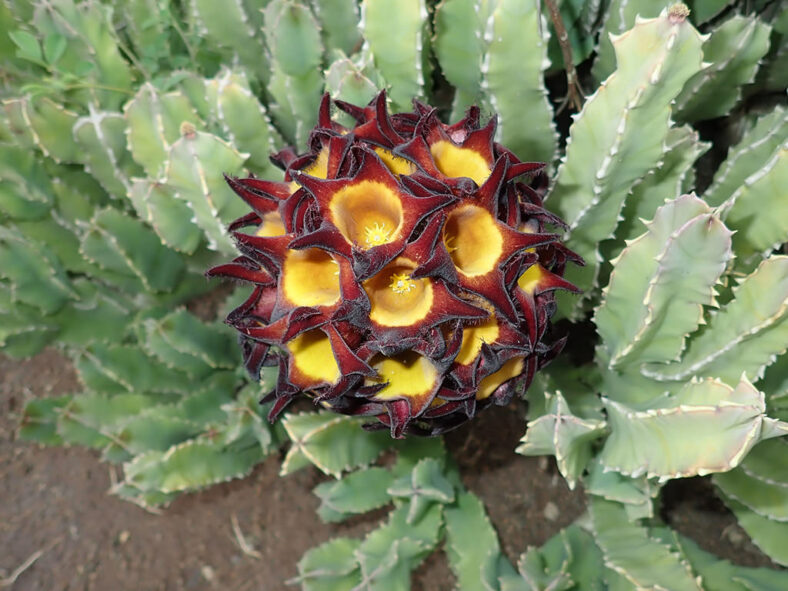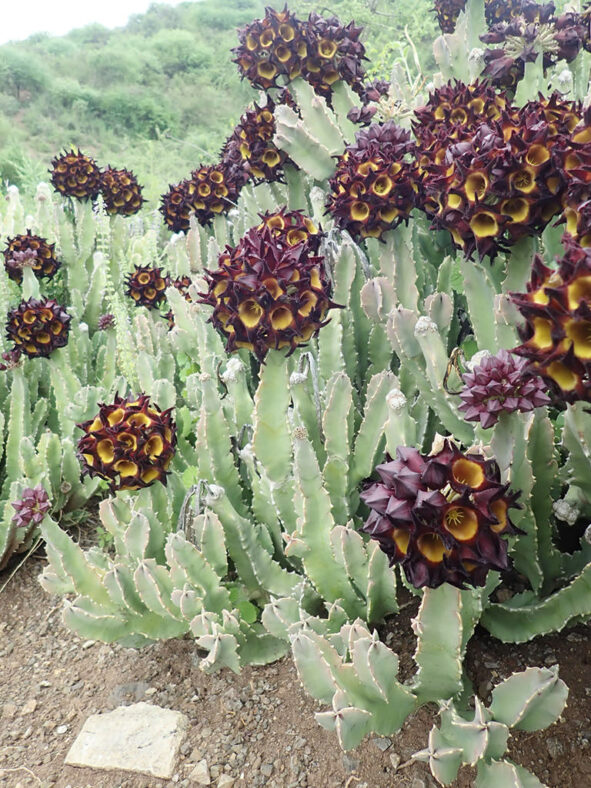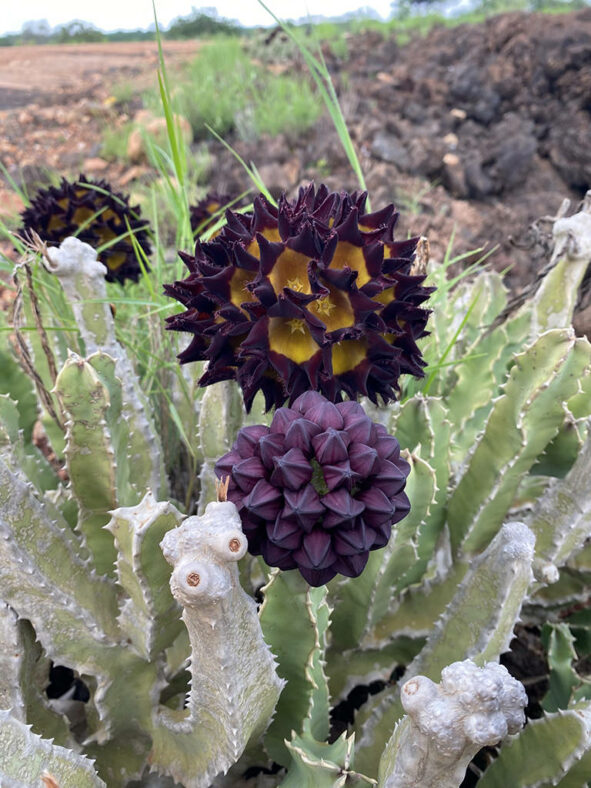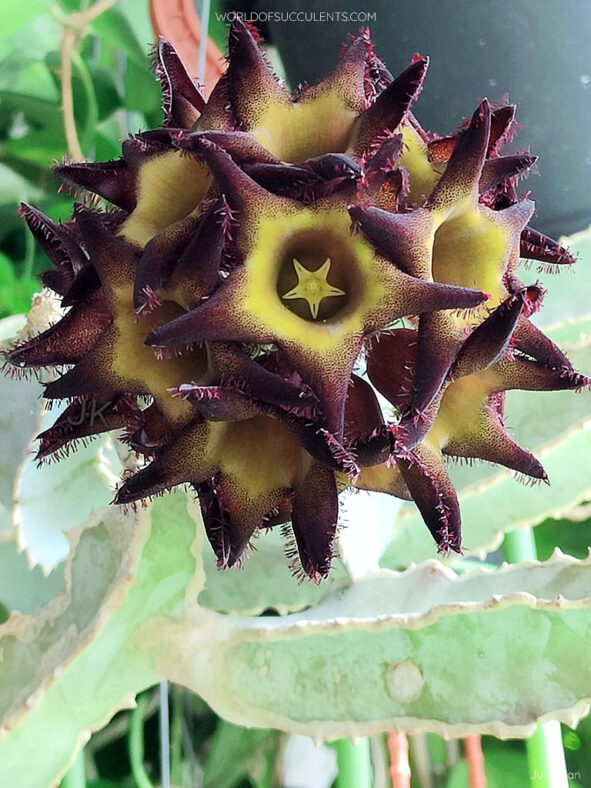Desmidorchis speciosa is an impressive clump-forming succulent that is simply breathtaking in the fall when it produces large clusters at the tips of its stems. It was first described by Nicholas Edward Brown in 1878 as Sarcocodon speciosus.
Scientific Name
Desmidorchis speciosa (N.E.Br.) Plowes
Synonym(s)
Caralluma speciosa, Ceropegia codonoides, Sarcocodon speciosus
Scientific Classification
Family: Apocynaceae
Subfamily: Asclepiadoideae
Tribe: Ceropegieae
Subtribe: Stapeliinae
Genus: Desmidorchis
Etymology
The specific epithet "speciosa" (pronounced "spee-see-OH-suh") means "showy, specious" and refers to the flowers of this species, which have a striking appearance.
Origin
Desmidorchis speciosa is native to Northeast and East Tropical Africa (Sudan, Ethiopia, Djibouti, Somalia, Kenya, Uganda, and Tanzania). It grows in semi-arid and other parts of dry savanna areas.
Description
Desmidorchis speciosa, formerly known as Caralluma speciosa, is a succulent plant that grows in clumps of erect or ascending, tetragonal stems. The stems range in color from olive-green to greyish-green and have ribs that soon harden into a light brown callus with short, hard teeth. They can grow up to 32 inches (80 cm) long and 1.4 inches (3.5 cm) thick.
In the fall, Desmidorchis speciosa produces attractive clusters of many flowers at the tip of the stems. The flower clusters can reach a diameter of 4 inches (10 cm), while the bell-shaped flowers can measure up to 1.2 inches (3 cm) in length and 1.3 inches (3.2 cm) in diameter. The corolla is yellow inside, with triangular, ascending, or spreading, purplish-black lobes adorned with numerous, versatile, club-shaped hairs along the margins. The corona is yellow with outer lobes, each with two thin, erect horns. The fruits are smooth follicles that can grow up to 4.8 inches (12 cm) long and contain broad, brown seeds with a tuft of hairs.

How to Grow and Care for Desmidorchis speciosa
Light: Desmidorchis speciosa prefers full sun but benefits from light shade on the hottest summer days. Indoors, place the plant near the brightest window in your home, as it will stretch if it doesn't receive enough sunlight. Avoid abruptly moving a plant adapted to lower light levels to full sun to prevent sunburn.
Soil: Use a commercial potting soil mix designed for succulents or prepare your own with 50% to 70% mineral grit, such as coarse sand, pumice, or perlite.
Temperature: The plant thrives in warm outdoor environments with low to moderate humidity. It does not like winter cold and should remain fairly dry and warm during its dormancy. Desmidorchis speciosa grows best in USDA Plant Hardiness Zones 11a to 11b, with average minimum winter temperatures ranging from 40°F to 50°F (4.4°C to 10°C).
Watering: It has typical watering needs for a succulent. During the growing season, from spring to fall, water the plant thoroughly and allow the soil to dry between waterings. When it goes dormant in winter, it needs almost no water, about once a month.
Fertilizing: To keep the plant healthy and thriving, fertilizing is a good idea. Feed it with water-soluble fertilizer diluted to half the recommended strength, but only when the plant is actively growing.
Repotting: Repot Desmidorchis speciosa in spring, just before the growing season. It has shallow roots and doesn't require a lot of soil to grow. Always pick a container with drainage holes.
Propagation: The best way to propagate this succulent is by using stem cuttings. To ensure good rooting, take cuttings during the growing season. The plant is also easy to start from seeds in the spring.
Learn more at How to Grow and Care for Stapeliads.
Toxicity of Desmidorchis speciosa
Desmidorchis speciosa has no reported toxic effects, so it is safe to grow around kids and pets.
Links
- Back to genus Desmidorchis
- Succupedia: Browse succulents by Scientific Name, Common Name, Genus, Family, USDA Hardiness Zone, Origin, or cacti by Genus
Photo Gallery
Click on a photo to see a larger version.


